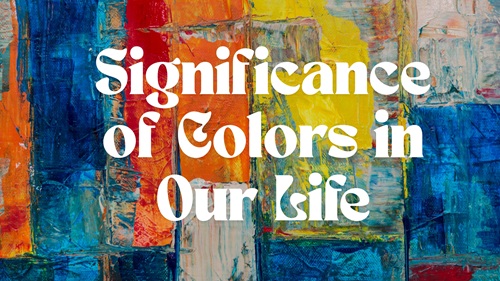A Splash of Color, A Shift in Mood
Close your eyes for a moment and imagine walking into a room bathed in soft, warm yellow light. Instantly, there’s a sense of comfort, almost like a gentle sunrise is hugging you. Now picture the same room painted in deep navy blue. Feels calmer, cooler, and maybe even a bit more introspective, right?
That’s the power of color, it’s not just what you see; it’s what you feel. The shades around you can lift your mood, slow your heartbeat, sharpen your focus, or even make you feel hungrier. And whether you realize it or not, your environment is constantly playing with your emotions through its palette.
Today, let’s explore the psychology of color, why certain hues make us feel a certain way, how brands use it to influence our choices, and how you can use color intentionally to improve your surroundings (and your mood).
How Colors Affect Your Mood: The Science & Emotion Connection
Colors influence our mood because they stimulate the brain in different ways. When light enters our eyes, it’s processed in the brain’s hypothalamus, which governs hormones, body temperature, and emotions. This is why certain colors can literally alter our heart rate, breathing, and stress levels.
From ancient civilizations using pigments in healing rituals to modern marketing using color to sell products, we’ve always had an emotional relationship with color.

The Psychology of Different Colors and Their Emotional Impact
Here’s how various colors in your surroundings might be shaping your mood:
1. Red – Energy, Passion, and Power
- Emotional effect: Stimulates excitement, energy, and urgency.
- Best for: Gyms, creative spaces, restaurants.
- Be careful: Overuse can cause stress or aggression.
- Fun fact: Many clearance sale signs are red because it grabs attention faster than any other color.
2. Blue – Calm, Trust, and Focus
- Emotional effect: Lowers blood pressure, reduces stress, promotes mental clarity.
- Best for: Bedrooms, offices, healthcare spaces.
- Be careful: Too much dark blue can feel cold or distant.
- Fun fact: Social media giants like Facebook and Twitter use blue to signal trustworthiness.
3. Green – Balance, Freshness, and Renewal
- Emotional effect: Brings harmony, relieves anxiety, and promotes relaxation.
- Best for: Living rooms, meditation spaces, cafes.
- Be careful: Neon greens can feel artificial or overwhelming.
- Fun fact: Studies show green spaces improve recovery rates in hospitals.
4. Yellow – Happiness, Optimism, and Warmth
- Emotional effect: Boosts mood, sparks creativity, and radiates warmth.
- Best for: Kitchens, creative studios, children’s play areas.
- Be careful: Too much bright yellow can cause restlessness.
- Fun fact: Babies tend to cry more in yellow-painted rooms.
5. Orange – Enthusiasm, Comfort, and Sociability
- Emotional effect: Encourages conversation, energy, and appetite.
- Best for: Dining areas, workout spaces, and social zones.
- Be careful: Can feel overwhelming if too bright.
- Fun fact: Many sports teams use orange for its high visibility and energetic vibe.
6. Purple – Creativity, Luxury, and Spirituality
- Emotional effect: Stimulates imagination, creativity, and a sense of mystery.
- Best for: Bedrooms, art studios, boutiques.
- Be careful: Deep purples can feel overly heavy if not balanced with lighter tones.
- Fun fact: Historically, purple dye was rare and expensive, symbolizing royalty.
7. White – Purity, Simplicity, and Openness
- Emotional effect: Creates space, clarity, and cleanliness.
- Best for: Minimalist designs, bathrooms, small rooms to make them look bigger.
- Be careful: All-white spaces can feel sterile without texture or accent colors.
- Fun fact: In some cultures, white is associated with mourning, not purity.
8. Black – Power, Sophistication, and Depth
- Emotional effect: Adds elegance, authority, and a sense of mystery.
- Best for: Accents, modern interiors, and high-end branding.
- Be careful: Too much black can feel oppressive or heavy.
- Fun fact: Luxury brands like Chanel and Gucci often use black for its timeless appeal.
9. Pink – Love, Compassion, and Playfulness
- Emotional effect: Promotes feelings of tenderness, romance, and kindness.
- Best for: Bedrooms, nurseries, beauty spaces.
- Be careful: Overuse can make a space feel overly “sweet” or juvenile.
- Fun fact: Some sports teams paint opponent locker rooms pink to subtly reduce aggression.
10. Brown – Stability, Comfort, and Reliability
- Emotional effect: Evokes warmth, security, and a connection to nature.
- Best for: Living rooms, libraries, rustic spaces.
- Be careful: Too much dark brown can feel dull or closed-in.
- Fun fact: Wood tones in furniture naturally bring brown’s grounding effects.
How to Use Color Psychology in Your Daily Life
- In your home: Choose colors that match the activity of each room.
- In your wardrobe: Wear colors based on the mood or impression you want to create.
- At work: Use blues for focus, greens for calm, and yellows for creative brainstorming.
- In branding: Match your brand colors with the emotions you want customers to feel.
My Personal Take on Color Psychology
I’ve personally experienced how a small change in color can transform my mood. When I switched my workspace from dull grey to soft green, my productivity improved noticeably. And every time I add a pop of yellow to my kitchen, mornings just feel happier.
The beauty of color psychology is that it’s simple, accessible, and incredibly powerful. Once you understand it, you can use it to design spaces and experiences that truly lift you up.
For more such Lifestyle related updates, please follow Popnewsblend.com.

Hi, I’m Prashant Jain — a curious soul, storyteller, and content creator at heart.I’ve always been drawn to the world of entertainment, travel, sports, health & lifestyle — not just as a writer, but as someone who genuinely lives these experiences. Whether I’m binge-watching the latest OTT series, exploring offbeat spiritual destinations in India, or diving deep into wellness routines and cricket match insights, I love sharing what I discover with like-minded readers.
PopNewsBlend is my way of blending personal journeys with meaningful stories — ones that inform, inspire, and keep you ahead of the curve. Everything I write comes from real observations, hands-on experiences, and a deep passion for understanding the world around us.
Discover more from Popnewsblend
Subscribe to get the latest posts sent to your email.







